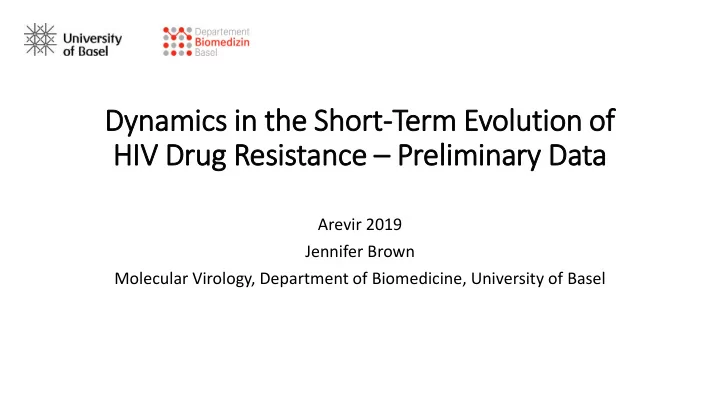

Dynamics i in the Short-Term rm E Evol olution on of of HIV D Drug g Res esistance e – Prelim limin inary Data ta Arevir 2019 Jennifer Brown Molecular Virology, Department of Biomedicine, University of Basel
Rationale Higher levels of drug resistance upon viremia in patients from Lesotho than Uganda or Switzerland 1 Standard of Care (WHO guidelines) Time point Switzerland, Uganda Patient on ART with viral load ≥ 1000 c/mL 2-3x adherence counselling Repeat viral load test after 3 months Time point Lesotho < 1000 c/mL ≥ 1000 c/mL Does the counselling process select for additional drug resistance? Some patients (31%) resuppress to < 1000 c/mL Patients with some resistance at the 1 st high viral load may acquire additional drug resistance during the 3-month counselling process 1. Bachmann et al ., JAC. 74(2):468-472 (2018). doi: 10.1093/jac/dky436.
Methods / Patient Characteristics Samples from CART trial (NCT02126696) in Lesotho 1 NGS analysis of samples before and after adherence counselling (3 month interval) Patients with 1 st and 2 nd VL ≥ 1000 c/mL (n=64; t1 available for n=48; t2 available for n=63) Patients with 1 st VL ≥ 1000 c/mL and 2 nd VL 80- 999 c/mL (n=12; t1 available for n=11; t2 available for n=11) Characteristics: % regimens containing following ARVs (2 NRTIs + 1 NNRTI for all) TDF 50% AZT 50% 3TC or FTC 100% EFV 60.34% NVP 39.66% 1. N. D. Labhardt et al., Medicine (Baltimore). 95(28):e3985 (2016). doi: 10.1097/MD.0000000000003985.
Preliminary Results – High Resistance at 1st VL 59 samples: 48 with sustained VL ≥ 1000 c/ mL ; 11 with partial resuppression to 80-999 c/mL Cut-off 5% Number of major Number (%) among Number (%) among Total (%) DRMs sustained VL ≥ 1000 partial resuppression c/mL to 80-999 c/mL 0 4 (8.3) 2 (18.2) 6 (10.2) 1 2 (4.2) 0 (0.0) 2 (3.4) 2 4 (8.3) 5 (45.5) 9 (15.3) 3 6 (12.5) 1 (9.1) 7 (11.9) > 3 32 (66.7) 3 (27.3) 35 (59.3) 4
Preliminary Results – Changes in NNRTI Resistance K103N K103S G190A G190S (62%), G190T (10%) (high resistance to NVP and EFV) (high resistance to NVP and EFV) K103N: high resistance to NVP and EFV; nonpolymorphic V106M: high resistance to NVP and EFV; nonpolymorphic ; particularly common in subtype C Y181C: high resistance to NVP; resistance also to other NNRTIs; nonpolymorphic G190A: high resistance to NVP; resistance also to other NNRTIs; nonpolymorphic
Preliminary Results – Changes in NRTI Resistance M41L: Moderate resistance to AZT and TDF; thymidine analog mutation (TAM) K65R: High resistance TDF, moderate resistance to 3TC/FTC, increased susceptibility to AZT (except in combination with Q151M); more likely to emerge in subtype C D67N: Moderate resistance to AZT; TAM K70R: Moderate resistance to AZT and low resistance to TDF; TAM L74I: May have compensatory effects on viral fitness, especially in the presence of NNRTI DRMs M184V: High resistance to 3TC/FTC, increased susceptibility to AZT and TDF and slows emergence of AZT and TDF resistance; associated with reduced viral replication K219Q: Moderate resistance to AZT when present with other TAMs; TAM
Preliminary Interpretation Exeptionally high rates of resistance at 1st high VL... ... probably since VL testing had only just been introduced (2014), and patients may had high VLs for many months/years. Trend towards an acquisition of additional drug resistance in patients who already have drug resistance starting EAC (majority in Lesotho)... ... calls into question the WHO-recommended policy of enhanced adherence counselling. More work to be done to assess the extent of potential harm (through selection for resistance) vs. benefit (no regimen change for those without resistance) of the adherence counselling approach in settings without access to resistance testing.
Thank you Molecular Virology Research Group: Thomas Klimkait Nina Marty Fabian Otte Lorena Urda Ulrike Seeburger Siro Ellenberger Olga Burger Niklaus Labhardt Karin Metzner Roger Kouyos Nadine Bachmann Herbert Mbunkah Christine Leemann
Recommend
More recommend